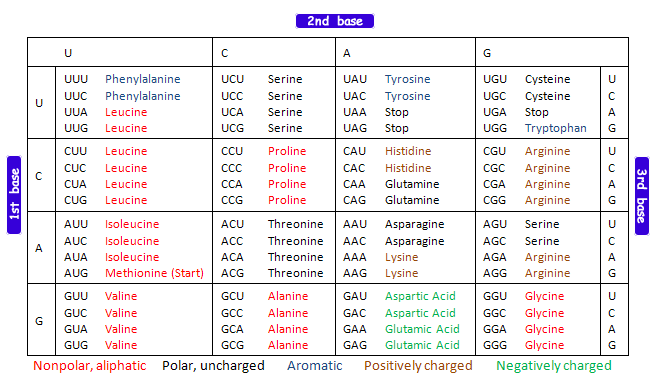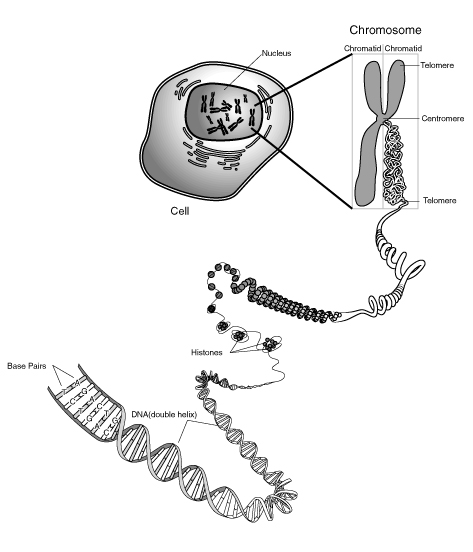Learning Outline
Mini Lesson: DNA
Deoxyribonucleic acid—the information molecule
Structure of DNA
Nucleotides
Nucleotide is the subunit, made of three components:
- Sugar (ribose in RNA; deoxyribose in DNA)
- Phosphate
- Nitrogen base
- Different types of nitrogen base: cytosine, guanine, adenine, thymine (DNA only), uracil (RNA only)
- First letters are used as abbreviations: C, G, A, T, U
- Bases may link C-G or G-C and T-A or A-T (in RNA, U-A or A-U)
- This rule is complementary or obligatory “base-pairing”
Nucleotides combine to form a double helix structure
- Sugar and phosphate groups link together to form the “backbones” of the double helix
- The nitrogen bases link in pairs to connect the two backbones
width=”150″ height=”148″ align=”left” hspace=”10″ />This classic photo of James Watson (l) and Francis Crick (r) shows them in 1953 with their original model for the double helix model of the DNA molecule.
Maurice Wilkins and Rosalind Franklin have also been given credit for participating in the discovery of this vitally important molecule’s structure and essential function. (Wilkins shared the 1962 Nobel Prize in Medicine/Physiology with Watson & Crick)
Researchers continue to unravel the many complexities and mysteries of what Watson called, “the most golden of all molecules.”
Genetish—language of genetics
Genetish is a made-up word introduced by author Matt Ridley to describe the coding used by cells in DNA/RNA
Codon
- Every three bases make up one “word” or codon in genetish
- Each different codon represents a different amino acid
- Amino acids combine to form polypeptides or proteins
Gene
- A sequence of codons containing the information needed to make one polypeptide/protein is called a gene (gene = “recipe” for one protein)
- A gene could also make more than one type of polypeptide
- A gene could instead make a functional RNA molecule
- Genes are found at various locations along a DNA molecule (chromatin/chromosome)
- All genes on all chromosomes is a set of information called the genome
Codon table. This table is a type of “phrasebook” for the language of “genetish” —-showing the meaning of different possible codons.
| Codon wheel. This is another type of “decoder” for determining which amino acid is represented by any codon. (clickimage to enlarge it and view source) |
Click here to see Ben Fry’s easier-to-read version of this classic table!
Ben constructed this as a student at MIT.
This version is similar to that found in our Anatomy & Physiology textbook (except that the textbook version is adapted to HUMAN genetish).
Function of DNA
The information molecule
Master code for proteins made by the cell
- Proteins perform functions that regulate the cell, make up parts of the cell, and regulate the synthesis (and breakdown) of other types of molecules (lipids, carbohydrates, so on)
In humans, temporary “working copies” of specific genes from DNA are in the form of RNA (review Cell Structure & Function)
Information “between the genes” formerly called “junk DNA” may also have functions in regulating gene expression, etc.
|
Acronym Table
|
|
| rRNA ribosomal RNA |
Forms ribosomes |
| mRNA messenger RNA |
Unfolded strand contains gene (code for one polypeptide); temporarily folds when leaving nucleus |
| tRNA transfer RNA |
Brings specific amino acids to ribosome and places them according to code on mRNA |
| nuclear DNA | “Master” genetic code in the nucleus |
| mDNA or mtDNA mitochondrial DNA | Additional “master” genetic code in the mitochondrion |
Optional: Click here for another helpful outline Making Proteins from the Pre-A&P course.
Replication of DNA
DNA helix “unzips” and nucleotides with bases complementary to those in each exposed DNA strand “fill in” and make a new side
- Results in two identical “daughter molecules” of DNA
- Semiconservative (half is new; half is old)
Facilitated by enzymes (isn’t everything?)
Transcription of RNA
Transcription 
mRNA is a “transcribed” copy of one gene in DNA
DNA unzips at one gene, and other side “fills in” with RNA nucleotides with bases that complement the exposed bases of the DNA strand
- Promoter — sequence of bases that tells the cell where to start transcribing the gene
- RNA polymerase — enzyme that facilitates formation of mRNA strand
Transcription
(click image to enlarge)
Editing
mRNA transcript is edited before leaving nucleus
- Introns — parts of sequence that are deleted (“nonsense”)
- Exons — parts of sequence the remain in the final mRNA molecule
- A structure called the spliceosome forms on the mRNA, facilitating the splicing of transcript (removal of introns, gluing together of exons)
DNA editing (simplified)
(click image for larger view)
Other forms of RNA (tRNA, mRNA) produced in a similar manner
- The edited transcript then usually folds into a complex shape, unlike the simple strand of mRNA
mRNA leaves nucleus via nuclear pores
Translation of RNA (protein synthesis) 
Location
- Translation occurs in the cytoplasm outside the nucleus
Process
- Initiation — mRNA associates with rRNA of ribosome
- Elongation — tRNA brings amino acids into place (anticodons on tRNA complement codons on mRNA) elongating string of amino acids
- Termination — protein is released
Translation.
Each tRNA (blue) brings a specific amino acid to ribosome (green) and links to the complementary codon on mRNA strand. As amino acids link together with peptide bonds, a polypeptide grows in length.
Mutations
Definition
- Chromosomal mutations — additions, deletions to chromosome
- Point mutations — change in one or few nucleotides in a gene sequence
Cause
- Mutations can be spontaneous (no known cause)
- Can be caused by radiation (x-ray, UV, etc.), chemicals, mechanical damage, extreme temperature, and other factors
Regulation of gene expression
Chromosome level
- Packing — DNA wraps around histone proteins, forming “beads” called nucleosomes
- Packing can prevent certain genes from being activated (transcribed)
Transcription level
- Master genes turn on a group of other genes
- Enhancer genes change the rate of transcription of other genes
- Regulatory chemicals, such as steroid hormones, may activate certain genes
- mRNA can be edited in different ways (exons can be linked in different ways)
- mRNA can be “made ahead of time” and then “masked” until needed later
Translation level
- Translation can be halted by regulatory mechanisms in the cell
- Interferon released by nearby virus-infected cells can trigger the activation of genes that produce translation-inhibiting proteins
- This causes the cell to be more careful in checking mRNA and will halt translation of viral RNA that has infected the cell
- RNA interference (RNAi)
- Mechanism by which translation of mRNA can be disrupted (interference)
- May help regulate gene expression
- May help defend against mutations and viral RNA infection
- Also called gene silencing
Location of DNA
Nucleus
- 46 chromosomes (diploid number) within nucleus (except during cell division)
align=”center”>
DNA location and structure.
Mitochondrion
- Single, ringlike strand of DNA comprising one chromosome
Mitochondrial DNA (mtDNA). This ringlike strand of DNA, similar to that seen in bacteria, contains genes that code for enzymes needed in mitochondrial function. Click on image to see larger source image, which is labeled with gene locations.

If you think about it, DNA is kind of like a cookbook, with genes being the individual recipes used to “cook up” the proteins of the body!
Kevin’s Mom’s Hot Milk Cake Recipe
Kevin’s Favorite Blueberry Oatmeal Cookie Recipe
Want to learn more about the DNA-cooking analogy?
See Survival Guide for Anatomy & Physiology: Tips, Techniques, and Shortcuts
Readings, References, & Resources
A&P Core
Betts, J. G., DeSaix, P., Johnson, J. E., Korol, O., Kruse, D. H., Poe, B., Wise, J. A., Womble, M., & Young, K. A. (2013). Anatomy and physiology.
Khan Academy. (n.d.). https://www.khanacademy.org/science/health-and-medicine
Patton, K. T. (2013). Survival Guide for Anatomy & Physiology. Elsevier Health Sciences.
Patton, K. T., Bell, F. B., Thompson, T., & Williamson, P. L. (2022). Anatomy & Physiology with Brief Atlas of the Human Body and Quick Guide to the Language of Science and Medicine. Elsevier Health Sciences.
Patton, K. T., Bell, F. B., Thompson, T., & Williamson, P. L. (2023). The Human Body in Health & Disease. Elsevier Health Sciences.
Patton, K. T., Bell, F. B., Thompson, T., & Williamson, P. L. (2024). Structure & Function of the Body. Elsevier Health Sciences.
Topic Focused
Coming soon!
This is a Learning Outline page.
Did you notice the EXTRA menu bar at the top of each Learning Outline page with extra helps?
Last updated: February 16, 2025 at 17:21 pm



